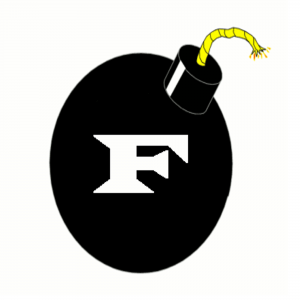Podcast: Play in new window | Download ()
Subscribe: Apple Podcasts | Spotify |

Unfortunately, with very few exceptions this has been the Team Handball TV viewing option for Americans outside of the Olympic Games.
In Part 5, I highlighted just how few fans of Team Handball there are and how instrumental TV broadcasts could be in turning that around. In this part I address the old Catch 22 paradox that has been largely responsible for keeping the sport off U.S. TV sets for years. (Part 1) (Part 2) (Part 3) (Part 4)
As I reflected upon in the last installment, there is nothing more effective in tearing down the basic “awareness” problem in the U.S. than TV broadcasts of the sport. The Olympics demonstrated that powerfully, but as the Olympics fades from memory, so unfortunately does Team Handball from the sports consciousness of Americans. The obvious solution is to continue broadcasting Team Handball matches on TV outside of the Olympics, but standing in the way is the old “Catch 22” TV paradox:
Team Handball will be more popular if it is shown on TV more. TV Networks will show more Team Handball on TV, but only if it becomes more popular.
Yes, unfortunately TV networks have decided they don’t much want to broadcast Team Handball on TV because it doesn’t have a built in audience ready to watch it. And therefore, USA Team Handball can’t use TV to build up that audience. Arggh!
But, is this truly a Catch 22? Or, are there ways to get around it? Yes, there are and some other sports have found ways to out maneuver the Catch 22. Basically, there are three ways to go about it:
1) A sport can get more popular first without the benefit of TV
2) A sport can convince a TV Network that it’s in their interest to get in on the ground floor and help further develop its growth
3) A sport can make broadcasts extremely cheap or even pay the TV Networks to show content
Here’s some top level analysis of these 3 solutions and why they haven’t been applied very successfully for Team Handball.
Getting more popular first without TV
As older Americans well know, 30-40 years ago soccer was shown on TV just about as often as Team Handball was. In other words, it was pretty much never broadcast with perhaps the exception of the short lived glory years of the NASL and a quirky highlight show on Public TV called “Soccer Made in Germany.” We all know that that is no longer true as pretty much every major soccer match played in Europe is now shown in the U.S. on some channel. And it’s pretty clear that this increased TV exposure is directly related to increased interest from the public. More people want to watch soccer, so the TV networks have responded. And soccer isn’t the only example of this. On a smaller scale lacrosse TV broadcasts have increased, but pretty much only as a result of its overall growth in the U.S. creating a growing audience.
So, if soccer and lacrosse can get more popular without TV, the USA Team Handball community should quit whining about no TV broadcasts and mimic what soccer and lacrosse have done. Right? Well, I suppose in theory one can make this argument, but it ignores just how deep a hole Team Handball is starting out in. The soccer analogy is appealing, but as I wrote in this article several years ago, even a farm kid in Iowa growing up in the 70s and 80s knew that soccer and lacrosse existed. And these sports had firmly established hotbeds in different regions of the country and were established NCAA sports. In theory, it’s possible that we could copy the paths of these sports, but it has been (and would be) tough to match their success. Not to mention the fact is it would likely take decades to get the growth needed.
Convincing a TV Network to get in on the ground floor and help out
It’s not definitive that TV networks will only broadcasts sports that have a large built in audience. At different times networks have decided to give a little push and promote a less popular sport in the hopes that it will have a breakout hit. Probably, the most prominent example was ESPN’s promotion of “extreme” sports through the creation of the X Games in the 1990s. Sure, there were a lot of kids already skateboarding and snowboarding, but the organization of these events into sports was lacking. As this article describes, the X Games were actually an internal ESPN idea which then had to seek out help from a pretty much non-existent sport structure to stage all these activities in a competition format. And the rest is history. A non-existent TV audience was immediately created and many of these sports have even found their way into the Olympics.
But, this success story was for individual, artistic sports. What about a team sport example? Staring Team Handball right in the face is the ongoing promotion of Rugby 7s by NBC. In a two part series (Part 1, Part 2), written in 2011, I highlighted the tremendous promotion the sport of Rugby is getting with NBC’s decision to broadcast the International World Series competition and now a collegiate competition. It’s so easy to imagine how something like this would be an incredible boost to Team Handball.
And while Rugby does have a significantly larger following than Team Handball in the U.S. the sport hasn’t developed a large enough audience to support broadcasts. No, NBC’s decision to devote significant resources to support and promote the sport is based on growth opportunities and in particular, the possibility of giving American football fans something to watch in the spring after the NFL season is over.
It’s also worth noting, that according to this interview with NBC Executive, Jon Miller, NBC contacted USA Sevens first to express interest in broadcasting the tournament. In terms of convincing, it’s always easier to sell someone who’s already interested, vice cold calling. The good news is that Mr. Miller and others at NBC know what Team Handball is, so maybe convincing them with still a little Olympics buzz around might yet be possible.
Make your TV broadcasts really cheap and/or pay for access
But, if you can’t convince the TV networks to help you promote your sport, you can always give them the TV rights for a reduced price or for free. And, if they won’t take free you can really bite the bullet and actually pay them to broadcast your sport. Ouch. Really, we’ve got to pay networks to put on such a great product? How can this be when there’s so much junk being shown on these networks. Case in point, take a look at the fine viewing options that were available to American viewer at the same time the European Championship final was being played in January. Why is this so?
Well, the reality is that free isn’t actually free when it comes to TV broadcasts. In addition to the “rights” to broadcast, there are costs associated with production and distribution. All those cameramen, cameras, sound crews and commentators aren’t free. (Well, you can get commentators for free sometimes (like me), but then you’re really reducing your overall production quality.)
And then once you have the packaged product it has to find its way from the arena to the airwaves. This isn’t free either and can cost several thousand dollars depending on the type of transmission. Reportedly, when ESPN provided a webstream broadcast of the 2009 Men’s World Championship, the U.S. Federation reportedly had to pay $1,500/match for the satellite uplinks. And that was for a live webstream, its surely more expensive for a broadcast like the Poland-Germany match a couple years ago.
The other little secret is that when a network fills airtime with repeats of fishing and hunting shows the reality is that the people that produce those shows actually pay to put them on TV. They are for all practical purposes infomercials. And while networks may prefer to show more traditional sports content that would probably draw a larger audience they are for the most part quite content to fill airtime and get a little money on the side.
Promotion is so important, however, that sports federations have often swallowed their pride and indeed paid to get their sport on TV. It’s not an easy decision, particular for marginal sports like Team Handball. Money to get on TV could also be spent in so many other ways. It could pay for a team trip to Europe or help start a new club. But, the counter argument is that maybe showing your national championship on TV will result in more players and fans. Which could lead to finding better players and better sponsorship. And, maybe, just maybe you could strike gold with some TV Exec seeing the light and deciding to produce and show the championship next year.
New distribution paths: An end to the TV Catch 22?
There are, however, new developments with TV webstreaming that could very well throw the old TV Catch 22 out the window. Heck, some would argue that the availability and quality of webstreaming already has. If you’ve checked out the quality of the Champions League efhTV broadcasts this year, you know what I’m talking about. Distribution via webstreaming is also cheaper and provides a path around the TV network gatekeepers.
As I write this in October of 2012, however, it’s too early to write off TV’s future. I may be happy watching webstreams, but I’m a super fan. To solve the awareness problem the sport needs to still be on traditional networks where new fans will be created. Maybe someday, we can ignore the gatekeepers, but unless there’s an Apple iTV “earthquake” in the near future we’re probably stuck with the old TV Catch 22 for a while. Where’s Steve Jobs when you need him?
So, to increase the sports awareness in the U.S. we need to convince TV networks to help promote the sport. Or, we can simply pay the networks or make it easily extremely cheap for them to show the sport on TV. How can a cash-strapped U.S. Federation make that happen? The answer is a little assistance from European handball entities, who would also benefit greatly from turning the U.S. into a handball nation. In Part 7 I’ll address why this hasn’t happened in the past, but why it’s starting to happen now.























